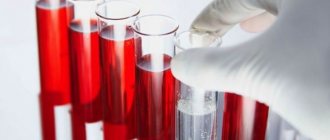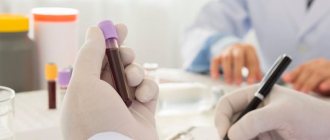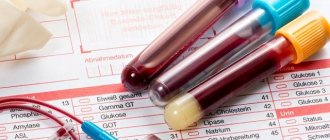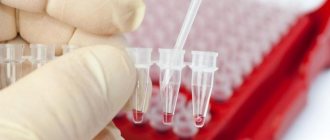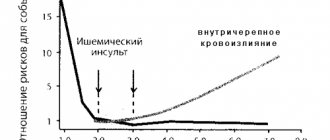Defects of the immune system can be suspected in the presence of repeated respiratory infections, in the presence of chronic inflammatory and autoimmune diseases, fungal and parasitic infections. Immunity examinations are also carried out to help with allergic diseases, severe common diseases requiring emergency care, in monitoring immunomodulatory therapy, to identify primary or secondary immunodeficiency, before and after organ transplantation, and in cancer. In addition to damage by the human immunodeficiency virus, secondary immunodeficiency develops after major surgical interventions, extensive, severe infections, and during therapy with immunosuppressive or strong anti-inflammatory drugs.
Immunity studies help in assessing the activity and stage of inflammatory, infectious and allergic immune responses, and the effectiveness of therapy. For this purpose, they are carried out repeatedly.
Clinical blood test with leukocyte formula
A clinical blood test with a leukocyte formula can identify many diseases. It reflects the state of hematopoiesis - the maturation and growth of blood cells in the bone marrow. The state of the immune system is indicated by the levels of white blood cells - leukocytes and the leukocyte formula. Monitoring the leukocyte formula in the dynamics of the disease will reveal complications, the spread of infection throughout the body, and the response to treatment.
With bacterial infections, you can see an increase in leukocytes and neutrophils with the appearance of their young forms in the blood.
With viral infections, on the contrary, leukocytes decrease, and lymphocytes predominate in the leukocyte formula.
The predominance of certain populations in the leukocyte formula helps in diagnosing the cause of inflammation. For example, in certain infections (for example, infectious mononucleosis), altered monocytes increase, and in allergic and parasitic diseases, eosinophils increase.
The presence of very young cells (blasts) in the blood is a sign of excessive activation of the bone marrow, and a low level of leukocytes and neutrophils without inflammation is a sign of its suppression.
What does total blood protein mean? Lecture for doctors
The clinical biochemistry term “total blood protein” is the sum of all proteins present in the blood at the time of analysis. Normally it should be 100 g/l. Although most reference books offer a standard standard of 65-85 g/l. But this “standard” obviously contains a misunderstanding of the obvious: the amount of all proteins present in the blood at the time of analysis is a rigid genetic constant. Normally, it cannot have such a clear individual variation. Why?
Let's give a purely biological answer to this question. About 100,000 proteins are synthesized in the body. Total protein, like the tip of this iceberg, indicates genetic and physiological well-being.
About 100 proteins can be detected in blood. The entire genome (approximately 8,000 genes) is a piece of DNA that can be mentally “stretched” to the full height of a person and even more. Its length is 2 m. The genes are packed into 46 chromosomes and with this DNA they provide information about all the 100,000 proteins that are actually synthesized.
Different cells have different numbers of genes. The most primitive cell - the red blood cell - does not have a nucleus, which means it does not have genes. But its predecessor, the reticulocyte, has eight genes. The largest number of functioning genes is in nerve cells: 1560 genes in one neuron. (In a liver cell - hepatocyte - 300 genes, in a kidney cell - 800 genes.) The more genes, the more amino acids and proteins are required. Therefore, the power of the nervous system to suck out amino acids is not comparable to any other living functional apparatus. It can be compared to the most powerful vacuum cleaner! In this regard, potentially, physiologically, there is always a shortage of amino acids in the whole organism, and this deficiency is especially felt by the brain.
The movement of amino acids to the brain is similar to the movement of electric trains during rush hour. During ontogenesis, the brain develops during life. And the more intense its development, the greater its need for amino acids. After all, gray matter and synapses are nothing more than amino acids and proteins. In the body of an adult, the level of protein under physiological conditions cannot undergo sharp fluctuations. There is always at least a slight deficiency in protein.
The formation of one peptide bond (to connect proteins from amino acids) requires about 15 ATP molecules - this is a very energy-intensive process. The disappearance of 1 g of protein from the blood means the loss of 30 g of protein in the tissues. If 2 g of protein leaves the blood, then twice as much will disappear from the tissues - 60 g of protein, 3 g will entail a loss of 90 g, 4 g - 120 g, etc. Therefore, we emphasize once again that total blood protein normally cannot have a significant spread of values if a person:
a) eats well,
b) not sick,
c) matured, is an adult.
In this case, the value of total blood protein is strictly genetically determined.
It follows that if two patients, all other things being equal, have different levels of total protein, then this should most often be considered as a sign of well-being in one case and a sign of severe ill-being in the other. It is better to have a high total protein value than a low one. For example, the number 85 is better than 65 because 65 indicates a deficiency:
- immune system;
- complement system;
— bactericidal protein system;
- fat transport systems.
Book “Rules for Reading Biochemical Analysis”
The manual is intended for doctors of any specialty. The reader is invited to begin the study of medical biochemistry with the selection and medical understanding of the information from fundamental biochemistry that is necessary for a doctor for practical use in a specific situation with a specific patient. At the same time, this information should provide guidance on a deep (down to the molecular level) understanding of pathology, taking into account the basic biochemical processes, which are better known in theory as pathogenetic mechanisms and are rarely mentioned (although they certainly should be mentioned) in a doctor’s practice.
Seventeen rules for reading biochemical analysis are presented in the form of text, color illustrated diagrams, brief formulas and comments, which makes the medical course understandable for a wide range of readers: students of medical universities, academies, faculties, doctors, researchers, and applicants. The book is adapted for an inquisitive person who is interested in his own body and wants to have modern scientific ideas about himself.
The manual was prepared by the chief researcher of the Research Institute of General Pathology and Pathophysiology of the Russian Academy of Medical Sciences, leading researcher of the Central Research Institute of Epidemiology of Rospotrebnadzor of the Russian Federation, Doctor of Medical Sciences. Igor Mikhailovich Rosly.
Buy the book “Rules for reading biochemical analysis”
Contents of the book “Rules for reading biochemical analysis”
Rule 1. Introduction to medical biochemistry
Rule 2. Blood enzymes for biochemical analysis
Rule 3. ACT and transamination
Rule 4. ALT Glucose-alanine shunt
Rule 5. Biological meaning of the work of two transaminases: ACT and ALT
Rule 6. GGT is an enzyme for membrane transport of amino acids
Rule 7. Total blood protein indicator
Rule 8. Molecular processes of realization of the genotype in the phenotype and their violations
Rule 9. The structure of proteins as an illustration of their structural and functional role in the formation of living systems
Rule 10. Albumin, urea and creatine - indicators of catabolism
Rule 11. The role of amino acids in ensuring cerebral processes during normal brain activity
Rule 12. Basic blood enzymes
Rule 13. What is important for a doctor to know about cholesterol
Rule 14. Alkaline phosphatase
Rule 15. Lactate dehydrogenase
Rule 16. Creatine phosphokinase
Rule 17. Energy exchange
Rule 18. Algorithm for biochemical analysis performed by a doctor
Rule 19. Integration of metabolic and enzymological indicators (“enzyme-metabolic fan”)
Rule 20. Homeokinesis
Rules for reading biochemical analysis - Rosly I. M.
Lymphocytes, immunophenotyping
There are different populations of lymphocytes that play a key role in directing the immune response - cellular or humoral. Determination of the immune phenotype of a lymphocyte is possible in a special study using flow cytometry. The phenotype of lymphocytes depends on special receptors on their surface - CD differentiation clusters. The presence of one or another receptor indicates that the cell belongs to a certain population of lymphocytes.
Cellular immunity is determined:
- B lymphocytes (CD19+)
- T-lymphocytes (CD3+) common and their subtypes:
- T helper cells (CD3+CD4+)
- T-cytotoxic (CD3+CD8+)
- T-killer cells (CD3+CD16+CD56+)
- Natural killer cells (CD3-CD16+CD56+)
- Lymphocytes with HLA-DR+ marker
- Immunoregulatory index (T-helpers/T-cytotoxic)
Additionally, other lymphocyte CD markers are examined to determine their activity.
Evaluation of the result is possible only in conjunction with data from the clinical picture and immunomodulatory therapy. Immunophenotyping of lymphocytes is usually carried out over time. Thus, in HIV infection that affects T-helper cells, a decrease in the level of CD3+CD4+ cells and the immunoregulatory index (CD3+CD4+/CD3+CD8+) has a poor prognosis for the course of the disease.
What does a decrease in the indicator mean?
If the beta-hCG standard according to the results of the blood test has not been achieved, the cause of this condition may be:
- Frozen and undeveloped pregnancy;
- Ectopic pregnancy of any location;
- Retarded intrauterine development of the embryo and fetus;
- There is a threat of premature birth or miscarriage;
- Fetoplacental insufficiency and premature aging of the placenta;
- Post-term pregnancy;
- Intrauterine fetal death in late pregnancy.
Important to remember! Only a specialist can evaluate the analysis. In cases where the results obtained and the norm do not coincide, it is necessary to repeat the studies after 2-3 days!
Circulating immune complexes and the complement system
Antigens are bound by specific antibodies to form immune complexes. The latter activate complement and promote the removal of foreign antigens. If there are too many of them circulating in the blood, they are deposited in tissues, such as the kidneys, skin, and lungs. High levels of circulating immune complexes (CIC) are observed in autoimmune, chronic inflammatory and infectious diseases. On the other hand, the determination of CEC in the blood is nonspecific and does not reflect either the reason for their increase or the direct effect on the organs.
A decrease in CEC levels during treatment indicates the subsidence of the inflammatory process and the effectiveness of therapy.
The most common tests for the complement system are the determination of the key C3 and C4 components. Indications for the study are recurrent infections, rheumatic and autoimmune diseases to identify congenital complement deficiencies that aggravate the course of these diseases.
The levels of CEC, C3 component and C4 component of complement are examined.
Standards and evaluation of the results obtained
The normal level of human chorionic gonadotropin depends on the duration of pregnancy. Cases of detection of this hormone in the blood of women outside of pregnancy, and even more so in men, exceeding 5 mU/ml cannot in any case be considered as the norm. The limits of physiological parameters of beta-chorionic gonadotropin are given in the table.
| Week of pregnancy | Normal value in honey/ml | Week of pregnancy | Normal value in honey/ml |
| 1-2 | 25 — 300 | 7-8 | 20000 — 200000 |
| 2-3 | 1500 — 5000 | 8-9 | 20000 — 100000 |
| 3-4 | 10000 — 30000 | 9-10 | 20000 — 95000 |
| 4-5 | 20000 — 100000 | 11-12 | 20000 — 90000 |
| 5-6 | 50000 — 200000 | 13-14 | 15000 — 60000 |
| 6-7 | 50000 — 200000 | 15-25 | 10000 — 35000 |
| 26-37 | 10000 — 60000 |
The normal course of pregnancy is characterized by a gradual increase in hCG concentration. During the first trimester, this process occurs at the fastest rate in the form of a doubling of the hormone concentration every 2-3 days. The peak of beta hCG activity corresponds to the period of placenta formation (10-12 weeks) and lasts for another 1-2 weeks, after which its level gradually decreases to relatively stable numbers, maintained until birth.
Excluding pathology of pregnancy and fetus is the main purpose of a blood test for hCG
Immunoglobulins A, M, G, E
Total immunoglobulins are indicators of the humoral immune response. IgM levels increase during the acute period of the disease and during exacerbation of chronic infection, IgG - during the recovery process, IgA - during the acute period of the disease, persisting longer than IgM, reflecting a protracted course and damage to the mucous membranes. Elevated IgE levels indicate allergic inflammation.
General immunoglobulins do not explain the cause of infection, so it is advisable to look at specific antibodies to specific pathogens. The main indications for determining total antibodies are suspicion of congenital immunodeficiency associated with humoral immunity.
Total immunoglobulin E, immunoglobulin G, immunoglobulin M, immunoglobulin A are examined.
In what cases are there indications for analysis?
Any study has clear indications, which are determined by its feasibility and informativeness in each specific case. Regarding human chorionic gonadotropin, it is advisable to donate blood in the following cases:
- Prolonged delay of menstruation (amenorrhea of any origin);
- Determination of pregnancy of any period, starting from 5-6 days after fertilization;
- Diagnosis of pregnancy pathology (ectopic, frozen, non-developing and multiple pregnancies, threat of miscarriage and miscarriage);
- If there is a suspicion of an incompletely performed medical abortion;
- Screening monitoring of the course of pregnancy (take scheduled tests for all pregnant women, without exception, from 12-14 to 17-18 weeks);
- Diagnosis of fetal malformations. The diagnostic value of hCG in this regard shows even better performance in combination with blood tests for alpha-fetoprotein (AFP) and estriol;
- Suspicions of malignant neoplasms from embryonic tissues (chorionepithelioma, hydatidiform mole), digestive system, ovaries and testicles.
References
- Septic complications in obstetrics. Clinical guidelines (treatment protocol), 2021. - 45 p.
- Methodological recommendations Algorithm for the use of procalcitonin during antibacterial therapy (including in patients with complicated forms of COVID-19). — Moscow Department of Health, 2021. — 26 p.
- Kent, A., Maha, A. Procalcitonin in Respiratory Diseases: Use as a Biomarker and guiding antibiotic therapy, 2021. - Vol. 15(4). — P. 296-304.



